Xin Q. Diesel Engine System Design
Подождите немного. Документ загружается.

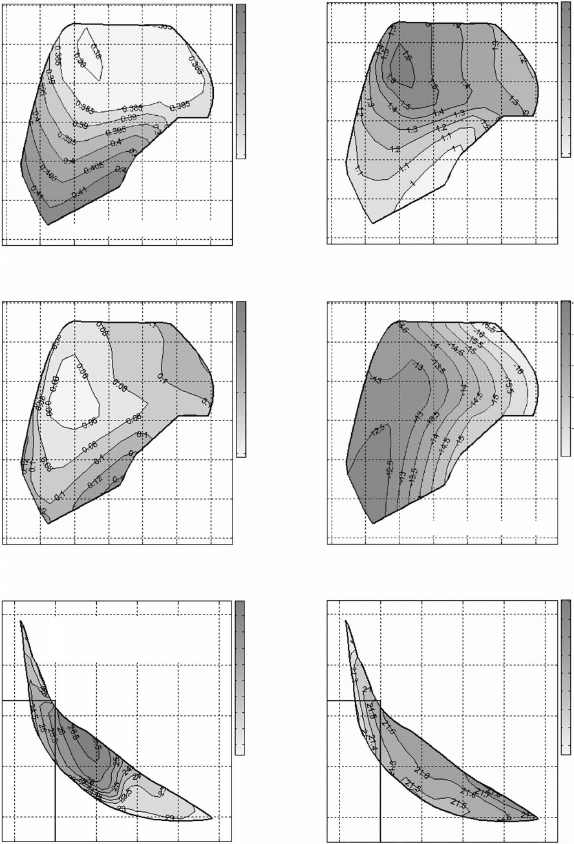
478 Diesel engine system design
© Woodhead Publishing Limited, 2011
single-cylinder engine emissions recipe to the design specications for the
multi-cylinder engine. Moreover, engine system design needs to cover the
following conditions: standard lab engine, different altitudes and ambient
temperatures, vehicle in-use installations, and engine transients.
21.9
21.8
21.7
21.6
21.5
21.4
21.3
21.2
21.1
0.415
0.41
0.405
0.4
0.395
0.39
0.385
0.38
Air–fuel ratio
Air–fuel ratio
Air–fuel ratio
Air–fuel ratioBSSoot (g/(hp.hr))
BS Soot (g/(hp.hr))
1.7
1.6
1.5
1.4
1.3
1.2
1.1
1
0.9
–12
–13
–14
–15
–16
22
21.8
21.6
21.4
21.2
21
20.8
22
21.8
21.6
21.4
21.2
21
20.8
22
21.8
21.6
21.4
21.2
21
20.8
22
21.8
21.6
21.4
21.2
21
20.8
0.25
0.2
0.15
0.1
0.05
0.25
0.2
0.15
0.1
0.05
0.15
0.1
0.05
26.5
26
25.5
25
24.5
24
23.5
23
22.5
BSFC (lb/(hp.hr))
BSSoot (g/(hp.hr))
EGR rate (%)
BSNO
x
(g/(hp.hr))
Boost P minus back P (in Hg)
Air–fuel ratio
1 lb/hp.hr = 608.3 g/kW.hr
1 inch Hg = 0.033864 bar
An alternative format is to
put BSNO
x
on the X axis
and BS Soot on the Y axis.
21 22 23 24 25 26 27
EGR rate (%)
21 22 23 24 25 26 27
EGR rate (%)
0.8 1 1.2 1.4 1.6 1.8
BSNO
x
(g/(hp.hr))
0.8 1 1.2 1.4 1.6 1.8
BSNO
x
(g/(hp.hr))
21 22 23 24 25 26 27
EGR rate (%)
21 22 23 24 25 26 27
EGR rate (%)
7.6 Advanced DoE calibration optimization on emissions, BSFC, and
air and EGR flows.
Diesel-Xin-07.indd 478 5/5/11 11:51:28 AM
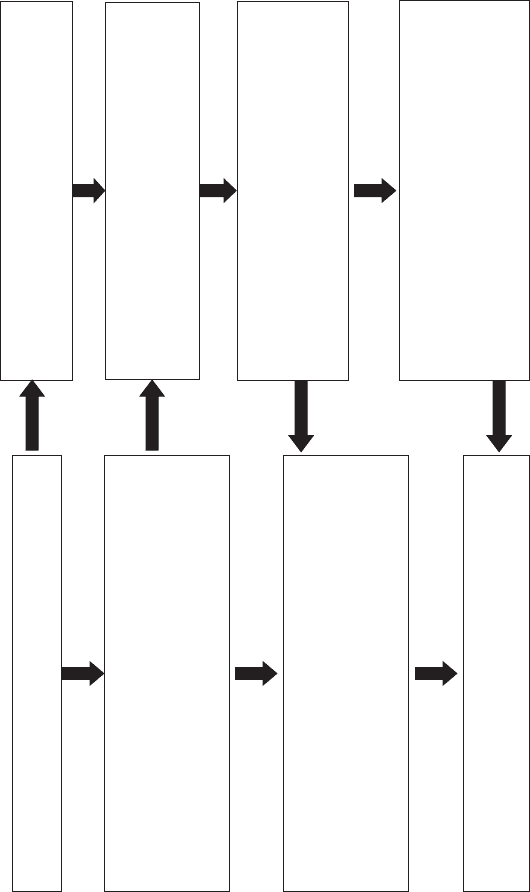
© Woodhead Publishing Limited, 2011
The work procedures in engine air system hardware
selection and design for steady-state development
Task 1: Evaluate emissions strategies to determine engine-
out emissions targets at critical speed/load modes.
Task 4: Determine air system requirements at minimum
engine delta P. Provide the requirements to suppliers.
Check their proposals, coordinate, and modify designs.
Task 2: Conduct single-cylinder or multi-cylinder
fundamental combustion and emissions experiments to
determine air system requirements at minimum engine
delta P and BSFC (i.e., intake manifold T, A/F, EGR rate,
fuel injection parameters) at critical speeds/loads with
selected fuel, combustion and intake port systems.
Task 3: Simulate the interaction between subsystems (i.e.,
exhaust restriction, charge air cooler size, EGR cooler size,
compressor efficiency, turbine efficiency, turbine effective
area, EGR circuit restriction, turbine wastegate, fuel
injection timing) at critical speed/load modes in order to
determine optimum system design.
The corresponding roles of engine cycle simulation
Engine cycle simulation needs to cover the
uncertainty of A/F ratio and EGR rate to prepare
for the situation of moving emissions targets.
Emissions testing conveys the required A/F ratio
and EGR rate to reach different moving targets
of emissions at critical speed/load modes (rated
power, peak torque, C50, B50, A50, A25, etc.).
Validate simulation model accuracy. Use DoE
approach to conduct cycle simulations to build
sensitivity charts of subsystem interaction at a
fixed emissions level to compare engine delta P
and BSFC. Repeat at critical speed/load modes.
Select the design point for subsystem
requirements based on sensitivity charts and
provide to suppliers. Simulate real hardware
(cooler effectiveness and flow restriction, EGR
valve restriction, turbo flow range and efficiency)
to check before running engine test.
7.7 Analytical procedure of engine air system design for steady-state operation.
Diesel-Xin-07.indd 479 5/5/11 11:51:28 AM
480 Diesel engine system design
© Woodhead Publishing Limited, 2011
7.3 Engine calibration optimization
7.3.1 Engine emissions behavior and steady-state
calibration optimization
Different combustion hardware provides different ranges of emissions
capabilities. Within a xed set of hardware, electronic controls of tunable
actuators such as the EGR valve and the common rail fuel injection system
are capable of altering the emission characteristics as a function of air system
parameters. In the system design, because the air ow requirements may be
an immature moving target, it is important to understand and document the
emissions behavior as a result of air ow variations in order to design the
system precisely and robustly. Emissions testing or simulation can reveal
the complex parametric dependency between the air system parameters and
the emissions. In contrast to the traditional trial-and-error ‘knob-turning’
rudimentary approach of tuning or calibration, modern automated engine
calibration or hardware screening is based on DoE emulator models. Engine
calibration can be so complex in a multi-dimensional factor space that even
an experienced calibrator cannot always nd the best settings without using
optimization. Unlike the ‘knob-turning’ approach where the data quality
is poor, the model-based calibration documents the engine’s sensitivities
completely, systematically, and concisely with optimization maps and
mathematical models in order to facilitate any future reuse.
The model-based approach ensures the minimum BSFC is found by
conducting optimization. Figure 7.6 shows the NO
x
and soot behavior in the
‘air–fuel ratio vs. EGR rate’ domain at a xed speed and load mode with a
given set of hardware. Each data point on the maps has the minimum BSFC
achievable within the factor range of the DoE. In this example, the maps are
bounded by the ranges of the factors (i.e., VGT vane opening, EGR valve
opening, fuel injection timing and injection pressure in this case). Different
combustion hardware can ‘shift’ or ‘rotate’ the map data so that the emissions
recipes may approach closer to or depart further away from the emission
regulation ‘box’ with different levels of BSFC. These optimized contour
maps in the sense of the minimum BSFC in the domain of emissions or air
system parameters are a powerful and concise tool for the system engineer
to judge the parametric sensitivities and to determine a precise and robust
performance functional target.
The above local optimization needs to be conducted by combustion/
emissions development at each critical speed–load mode. After the air
system functional targets are derived, system simulation can be conducted,
often with the DoE optimization method, to produce the hardware design
specications as well as the smooth steady-state performance simulation maps
in the global speed–load domain. Such a ‘virtual calibration’, an example
of which is shown in Fig. 7.8, may be used to identify the problems in the
Diesel-Xin-07.indd 480 5/5/11 11:51:29 AM
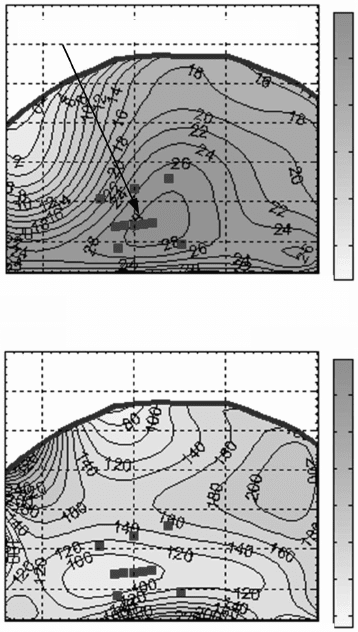
481Combustion, emissions, and calibration for system design
© Woodhead Publishing Limited, 2011
combustion/emissions recipe or the problems in the calibration optimization
for best emissions, drivability, and fuel consumption.
Diesel engine performance and emissions calibration are summarized by the
MathWorks-hosted SAE Panel Discussion (The MathWorks, 2007). Internal
combustion engine calibration automation is introduced by Kampelmuhler
et al. (1993), Schmitz et al. (1994), Ullmann et al. (2005), Jones and Muske
(2007), and Foster (2008). Simulation-based calibration (related to virtual
calibration) is explored by Onder and Geering (1995), Rask and Sellnau
(2004), Kim and Guezennec (2005), Millich et al. (2005), and Neumeister
et al. (2007). Model-based steady-state engine calibration is presented by
Stuhler et al. (2002), Burk et al. (2003), Nozaki et al. (2005), Vora et al.
(2005), Schlosser et al. (2006), and Diewald et al. (2009). Special application
calibrations (e.g., dual-use) are described by Kna et al. (2005).
EGR rate (%)
Engine speed
Engine speed
Engine delta P (mbar)
Steady-state vehicle driving points
Engine brake torqueEngine brake torque
25
20
15
10
5
0
400
350
300
250
200
150
100
50
7.8 Virtual engine calibration simulation in speed–load domain.
Diesel-Xin-07.indd 481 5/5/11 11:51:29 AM
482 Diesel engine system design
© Woodhead Publishing Limited, 2011
Idle (including low idle) is an important mode in engine calibration for
emissions, fuel economy, noise and vibration. The research on low idle
performance was conducted by Khan et al. (2006), Pekula et al. (2003).
Toback et al. (2004), MacMillan et al. (2009), Ghaffarpour et al. (1995,
2006), and Ghaffarpour and Noorpoor (2007).
7.3.2 Rapid transient calibration optimization
In order to conduct transient emissions calibration and modeling, the
characteristics of the transient emissions need to be understood. Detailed
information can be found in Chen and Yanakiev (2005), Urano et al.
(2005), Kang and Farrell (2005), Hagena et al. (2006), and Alberer and Re
(2009).
The above-mentioned DoE approach is well suited for steady-state
engine emissions calibration, but is cumbersome for transient calibration of
emission regulatory cycles due to its difculty of surface-tting the highly
nonlinear, fast-changing, time-dependent response data. Transient calibration
and control optimization has been a bottleneck in the engine development
process and is very time-consuming and expensive. Neural network modeling
provides a solution to this problem. A large amount of transient cycle engine
test data with a systematic perturbation of all the calibratable parameters
(including the transient gains) is used to train and build the neural network
model. Then, the model can be used to predict the transient emissions and
the BSFC. Optimization can be steered to minimize BSFC subject to the
weighted constraints of emissions, drivability, and durability. Details of
model-based transient calibration are given by Atkinson and Mott (2005).
Transient performance analysis is elaborated in Chapter 14. Model-based
transient calibration is discussed by Meyer and Greff (2002), Atkinson and
Mott (2005), Knaak et al. (2005), and Atkinson et al. (2008). Neural network
modeling of diesel engine emissions is investigated in Traver et al. (1999),
Thompson et al. (2000), and Desantes et al. (2002).
7.4 Emissions modeling
7.4.1 Oxygen mass fraction calculation
NO
x
emissions are related mainly to two fundamental parameters in the
engine: the in-cylinder oxygen concentration and the gas temperature. Lower
oxygen concentration and gas temperature lead to lower NO
x
. The in-cylinder
oxygen concentration is related to the air amount inducted and the trapped
residue gas fraction. There is a direct correlation between the in-cylinder
oxygen concentration and the intake manifold oxygen (O
2
) mass fraction for
EGR engines. The oxygen mass fraction and the in-cylinder gas temperature
Diesel-Xin-07.indd 482 5/5/11 11:51:29 AM
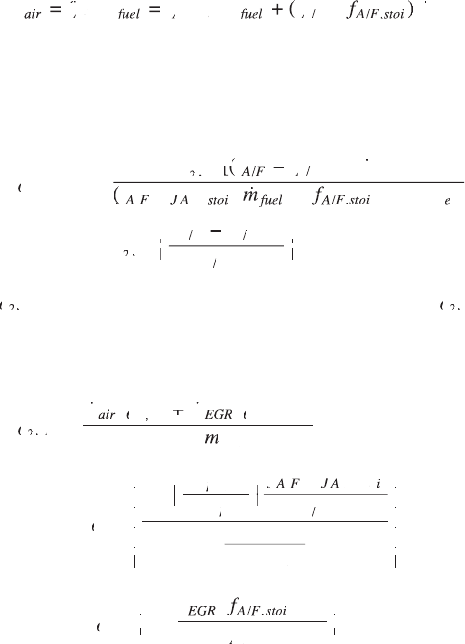
483Combustion, emissions, and calibration for system design
© Woodhead Publishing Limited, 2011
are affected by many engine design and operating parameters, for example
ambient air humidity, EGR rate, air–fuel ratio, trapped residue gas fraction,
fuel injection timing, heat release rate, intake manifold gas temperature,
engine coolant temperature, and engine compression ratio. NO
x
decreases as
EGR rate increases since EGR reduces both the oxygen concentration and
the in-cylinder ame temperature. In many cases NO
x
decreases as air–fuel
ratio decreases because of the reduction in the intake manifold oxygen
concentration, although the calculated in-cylinder thermodynamic bulk gas
temperature may appear to increase as the air–fuel ratio decreases (introduced
in Chapter 4). The oxygen mass fraction is an important parameter in engine
emissions analysis. Its calculation method is introduced below.
The stoichiometric air–fuel ratio can be calculated based on the
chemical balance of the stoichiometric combustion of a diesel fuel with a
given composition of carbon and hydrogen atoms (Heywood, 1988). The
stoichiometric air–fuel ratio can be on the basis of either dry air or humid
air. The engine air mass ow rate can be calculated as follows:
mf
mf
mf
mf
mf
mf
mf
ai
mf
rA
mf
rA
mf
Ff
mf
Ff
mf
lA
mf
lA
mf
F,
st
oi
stoist
fuel
mf
fuel
mf
AF
mf
AF
mf
mf =mf
mf
rA
mf =mf
rA
mf
rA
rA
mf
rA
mf mf
rA
mf
mf= mf
mf
lA
mf= mf
lA
mf
mf + (mf
–
//
mf
//
mf
Ff//Ff
mf
Ff
mf
//
mf
Ff
mf
mf
ue
mf
//
mf
ue
mf
mf
Ff
mf
ue
mf
Ff
mf
//
mf
Ff
mf
ue
mf
Ff
mf
lA//lA
mf
lA
mf
//
mf
lA
mf
F,//F,
//
mf mf
//
mf mf
Ff
Ff//Ff
Ff
mf
Ff
mf mf
Ff
mf
//
mf
Ff
mf mf
Ff
mf
mf
ue
mf mf
ue
mf
//
mf
ue
mf mf
ue
mf
mf
Ff
mf
ue
mf
Ff
mf mf
Ff
mf
ue
mf
Ff
mf
//
mf
Ff
mf
ue
mf
Ff
mf mf
Ff
mf
ue
mf
Ff
mf
mf
lA
mf mf
lA
mf
//
mf
lA
mf mf
lA
mf
mf
lA
mf= mf
lA
mf
//
mf
lA
mf= mf
lA
mf
/
AF/AF
fm
ffmf
fm
AF
fm
ffmf
AF
ffmf
fm
st
fm
fm
oi
fm
fm
st
fm
oi
fm
st
fm
fuel
/,
fm
/,
fm
fm
AF
fm
/,
fm
AF
fm
fm)fm
fm
fm
7.2
where the rst term represents the reacting air ow in the combustion process
and the second term represents the non-reacting air ow. Since there is no O
2
in the exhaust of the stoichiometric reacting ow, the oxygen mass fraction
in the exhaust gas can be calculated by the following:
f
ff
O
f
O
f
exhaus
t
Oa
ff
AF
ff
AF
ff
AF
ff
st
oi
stoist
fuel
2
2
Oa
2
Oa
,
,/
ff
,/
ff
Oa,/Oa
ir,/ir
ff
AF
ff
,/
ff
AF
ff
/,
AF/,AF
=
[(
ff[(ff
,/
[(
,/
ff
,/
ff[(ff
,/
ff
ff – ff
)]
m)]m
fuel
)]
fuel
f
Oa
f
Oa
)]
)]
(((
)
(
+ 1)
//
(
,/
(
,/
)
,/
)
,/
,
(
,
(
ff
(((ff(((
//
ff
//
–
//
– ff –
//
–
mf
) mf)
+ mf+
( mf(
,/
mf
,/
)
,/
) mf)
,/
)
+
,/
+ mf+
,/
+
(
,/
( mf(
,/
(
,/
mf
,/
)
,/
) mf)
,/
)
m
ff
AF
ff
//
ff
//AF//
ff
//
AF
//AF//
//
ff
//AF//
ff
//
,/st,/
,/oi,/
,/st,/oi,/st,/
fuel
,/fuel,/
) mf)
fuel
) mf)
,/
mf
,/fuel,/
mf
,/
)
,/
) mf)
,/
)
fuel
)
,/
) mf)
,/
)
AF
(
AF
(
,/AF,/
(
,/
(
AF
(
,/
(
,/
mf
,/AF,/
mf
,/
(
,/
( mf(
,/
(
AF
(
,/
( mf(
,/
(
st
(
st
(
oi
(
oi
(
stoist
(
st
(
oi
(
st
(
fu
(
(
+ 1)
+ 1)
mf
mf
) mf)
) mf)
( mf(
( mf(
el
eele
Oa
ir
AF
st
oi
stoist
AF
f
Oa
f
Oa
ff
AF
ff
AF
f
AF
f
AF
=
+
1
2
Oa
2
Oa
,
Oa,Oa
//
AF//AF
ff
//
ff
AF
ff
AF//AF
ff
AF
AF
ff
AF//AF
ff
AF
ff – ff
//
ff – ff
,
/
AF/AF
Ê
Ë
Á
Ê
Á
Ê
Ë
Á
Ë
ˆ
¯
˜
ˆ
˜
ˆ
¯
˜
¯
7.3
where
f
Oa
f
Oa
f
ir
2
Oa
2
Oa
,
Oa,Oa
is the mass fraction of O
2
in the ambient air, and
f
OD
f
OD
f
ryAi
r
2
OD
2
OD
,
OD,OD
= 0.231.
For combustion of US No. 2 diesel fuel with dry air, f
A/F,stoi
= 14.5.
The oxygen mass fraction of the intake manifold charge (i.e., the mixture
of fresh air and EGR) is given by the following:
f
mf
mf
m
OI
f
OI
f
M
OIMOI
mf
ai
mf
rO
mf
rO
mf
ai
rE
mf
rE
mf
mf
GR
mf
O
mf
O
mf
exhaus
t
ai
r
2
OI
2
OI
22
mf
22
mf
ai
22
ai
rE
22
rE
mf
rE
mf
22
mf
rE
mf
mf
GR
mf
22
mf
GR
mf
O
22
O
mf
O
mf
22
mf
O
mf
,
OI,OI
,,
22
,,
22
mf
22
mf
,,
mf
22
mf
ai
22
ai,,ai
22
ai
rE
22
rE,,rE
22
rE
mf
rE
mf
22
mf
rE
mf
,,
mf
rE
mf
22
mf
rE
mf
mf
GR
mf
22
mf
GR
mf
,,
mf
GR
mf
22
mf
GR
mf
O
22
O,,O
22
O
mf
O
mf
22
mf
O
mf
,,
mf
O
mf
22
mf
O
mf
=
+
rE
+
rE
rE
22
rE
+
rE
22
rE
+
mf
mf
mf
mf
mmm
EG
R
EGREG
=
1 +
1 –
(
2
,
//
,
f
f
f
ff
(ff(
//
ff
//
–
//
– ff –
//
–
Oa
2
Oa
2
,Oa,
f
Oa
f
ir
EG
f
EG
f
R
EGREG
EG
f
EG
f
R
EGREG
ff
AF
ff
//
ff
//AF//
ff
//
AF
//AF//
//
ff
//AF//
ff
//
st
o
stost
Ê
Ë
Ê
Ë
Ê
Ê
Á
Ê
Ë
Á
Ë
Ê
Ë
Ê
Á
Ê
Ë
Ê
ˆ
¯
ˆ
¯
ˆ
ˆ
˜
ˆ
¯
˜
¯
ˆ
¯
ˆ
˜
ˆ
¯
ˆ
iii
AF
EG
R
EGREG
f
AF
f
AF
f
EG
f
EG
)
(
AF
(
AF
(
f( f
AF
f
AF
(
AF
f
AF
+ 1)
1
(
1 –
)
/
AF/AF
(
/
(
AF
(
AF/AF
(
AF
È
Î
Í
È
Í
È
Í
Í
Í
Í
Í
Í
Í
Í
Í
Î
Í
Î
Í
Í
Í
˘
˚
˙
˘
˙
˘
˙
˙
˙
˙
˙
˙
˙
˙
˙
˚
˙
˚
˙
˙
˙
7.4
=
1 –
(
+ 1)
+ 1
2
,
/,
(
/,
(
/
f
ff
( ff(
f
Oa
2
Oa
2
,Oa,
f
Oa
f
ir
ff
EG
ff
RA
(
RA
(
ff
RA
ff
( ff(
RA
( ff(
ff
EG
ff
RA
ff
EG
ff
Fs
(
Fs
(
/,Fs/,
(
/,
(
Fs
(
/,
(
to
(
to
(
i
(
i
(
AF
/AF/
f
AF
f
È
Î
Í
È
Í
È
Î
Í
Î
˘
˚
˙
˘
˙
˘
˚
˙
˚
Diesel-Xin-07.indd 483 5/5/11 11:51:31 AM
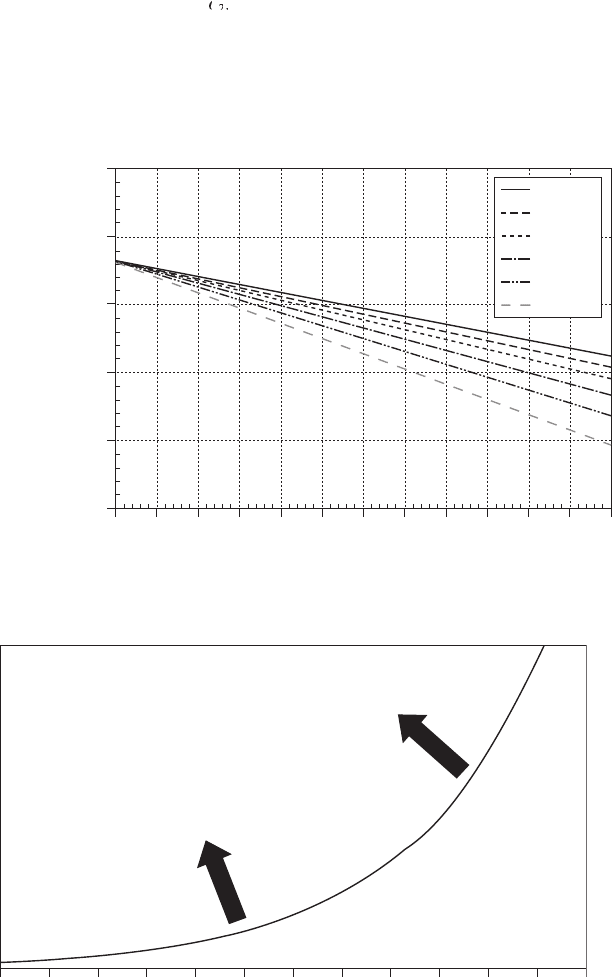
484 Diesel engine system design
© Woodhead Publishing Limited, 2011
For humid air, the terms
f
Oa
f
Oa
f
ir
2
Oa
2
Oa
,
Oa,Oa
and f
A/F,stoi
in equation 7.4 need to account
for the effect of humidity. Figure 7.9 shows the oxygen mass fraction of
the intake manifold charge as a function of EGR rate and air–fuel ratio for
dry air.
Figure 7.10 illustrates a simple conceptual model for the diesel engine
NO
x
as a function of oxygen mass fraction. Emissions modeling is important
Intake manifold oxygen mass fraction
0.3
0.25
0.2
0.15
0.1
0.05
0% 5% 10% 15% 20% 25% 30% 35% 40% 45% 50% 55% 60%
EGR rate
A/F = 30
A/F = 27
A/F = 24
A/F = 21
A/F = 18
A/F = 15
7.9 Intake manifold charge oxygen mass fraction as a function of
EGR rate and air–fuel ratio (dry air).
0.12 0.13 0.14 0.15 0.16 0.17 0.18 0.19 0.20 0.21 0.22 0.23 0.24
Intake manifold oxygen mass fraction
Higher intake
manifold
temperature leads
to higher NO
x
Fuel injection
timing advance
leads to higher
NO
x
Brake specifi c NO
x
(g/(hp.hr))
7.10 Conceptual NO
x
model as a function of intake charge oxygen
fraction.
Diesel-Xin-07.indd 484 5/5/11 11:51:31 AM
485Combustion, emissions, and calibration for system design
© Woodhead Publishing Limited, 2011
for engine system design. In addition to the experimental approach to predict
the relationship between the emissions and the air system parameters,
emissions simulation is also promising for establishing the air ow functional
requirements in a more cost-effective way. Four types of emissions modeling
approach are overviewed below.
7.4.2 Empirical approach
A primitive but useful approach used in the engine industry to predict emissions
is to build empirical parametric correlations among engine performance
test data. There are two types of such models: (1) to directly plot without
surface-t, for example, plot with Microsoft Excel the curves of NO
x
vs.
oxygen concentration and intake manifold gas temperature, soot vs. air–fuel
ratio or EGR rate; and (2) to surface-t the DoE engine test data to build
mathematical emulators of the emissions as functions of either the engine
calibration parameters (e.g., the EGR valve opening and the fuel injection
timing) or the performance parameters (e.g., the air–fuel ratio and the EGR
rate). Two examples are shown in Fig. 7.11. The advantages of such an
approach include the availability of a large amount of engine test data, ease
of plotting, ability to obtain data trends through regression or surface-t
and a quick estimation of the emissions. The disadvantages include being
purely empirical, lacking fundamental or governing physics in the deduced
correlations or the emulator models, lacking real-time predictability and
feasibility to be implemented in future advanced intelligent engine controls,
and the fact that the predictability is limited to the engine hardware from
which the test data are generated.
7.4.3 Zero-dimensional approach
In zero-dimensional models, the in-cylinder volume is treated as a single
zone or divided into burned and unburned zones without modeling the details
of the fuel spray and the turbulent air entrainment (Zhang, 1998; Lafossas
et al., 2007).
Useful information on the zero-dimensional emissions models can be
found in Nightingale (1975), Lipkea and DeJoode (1994), Dodge et al.
(1996), Zhang (1998), Easley et al. (2000), Yang et al. (2002), Kolade et al.
(2004), Ponti et al. (2007), Lafossas et al. (2007), a group of researchers at
the Lund University in Sweden (Egnell, 1998, 1999, 2000; Andersson et al.,
2006a, 2006b; Ericson et al., 2006; Wilhelmsson et al., 2009), and a group
of researchers at the National Technical University of Athens in Greece
(Kouremenos et al., 1997; Rakopoulos and Hountalas, 1998; Rakopoulos
et al., 1999; Pariotis et al., 2006).
Diesel-Xin-07.indd 485 5/5/11 11:51:31 AM
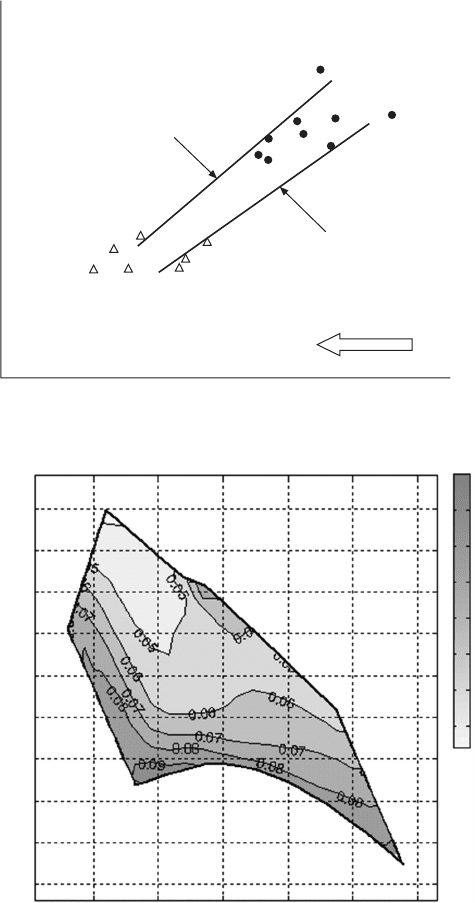
486 Diesel engine system design
© Woodhead Publishing Limited, 2011
BSNO
x
(g/(hp.hr))
Intake manifold oxygen concentration
(a)
Predicted recipe for
lower emissions
Hotter intake
manifold gas
temperature
Colder intake
manifold
temperature
Higher
emissions
data
EGR increase
Air–fuel ratio
25.6
25.4
25.2
25
24.8
24.6
24.4
24.2
24
23.8
22 24 26 28 30 32
EGR rate (%)
(b)
0.1
0.09
0.08
0.07
0.06
0.05
0.04
7.11 Empirical emissions modeling: (a) direct plot; (b) DoE
optimization emulator model.
BSSoot (g/(hp.hr))
Diesel-Xin-07.indd 486 5/5/11 11:51:32 AM
487Combustion, emissions, and calibration for system design
© Woodhead Publishing Limited, 2011
7.4.4 Phenomenological approach
A typical traditional phenomenological combustion and emissions model is
the diesel jet model developed from Cummins, Inc. The model simulates the
mixing rate of fuel spray and air, and calculates the local gas temperature,
the air–fuel ratio and the combustion in each zone of spray so that the
computed in-cylinder gas properties vary with both space and time. The
advantages of such a model include the fact that some combustion physics
and chemistry are built into the model. In addition, with proper tuning the
model has limited predictability on the heat release rate and the NO
x
. The
disadvantages include the following:
∑ many simplied assumptions concerning spray penetration, turbulence,
swirl, heat transfer, vapor concentration distribution, wall impingement,
ame propagation, combustion, and emissions formation
∑ the practical difculty of obtaining in-cylinder experimental data to
justify or calibrate each sub-model for industry use
∑ many model tuning parameters as a result of many detailed sub-
models
∑ the difculty of evaluating many design parameters related to the
combustion chamber and the air–fuel–combustion system matching
because those factors cannot be built into the model
∑ inability to predict particulate matter and soot accurately
∑ the fact that it is computationally intensive, and it is impossible to
implement in real-time simulations or intelligent engine controls at
current computer speeds.
It seems that the focus of the traditional phenomenological modeling may
be directed toward assisting the development of the more practical heuristic
macro-parameter-dependent modeling (to be introduced below), instead of
trying to become a stand-alone design tool, at least from a diesel engine
system design point of view.
More detailed information on the phenomenological emissions models can
be found in Hiroyasu and Kadota (1976), Chiu et al. (1976), Kyriakides et al.
(1986), Bazari (1992), Yoshizaki et al. (1993), Huang et al. (1996), Morel
and Wahiduzzaman (1996), Wang et al. (1999), Hiroyasu and Long (2000),
Torkzadeh et al. (2001), Kouremenos et al. (2001), Bayer and Foster (2003),
Asay et al. (2004), Brahma et al. (2005), Pariotis et al. (2005), Arrègle et
al. (2006), Mauviot et al. (2006), and Bagal et al. (2009).
7.4.5 Computational fluid dynamics (CFD)–KIVA modeling
The three-dimensional KIVA is a very complex multi-zone combustion
model based on the partial differential equations of viscous uid dynamics,
Diesel-Xin-07.indd 487 5/5/11 11:51:32 AM
